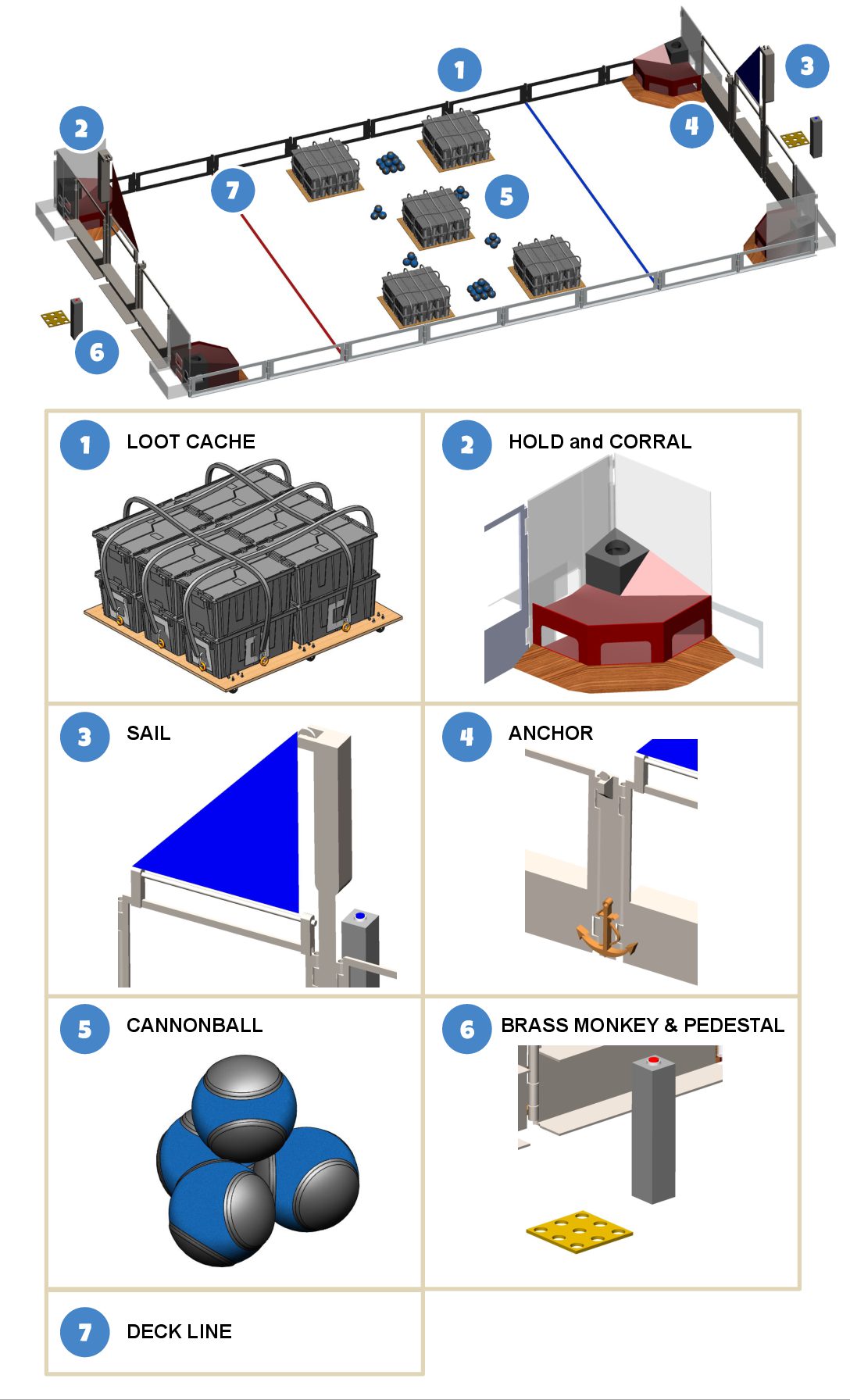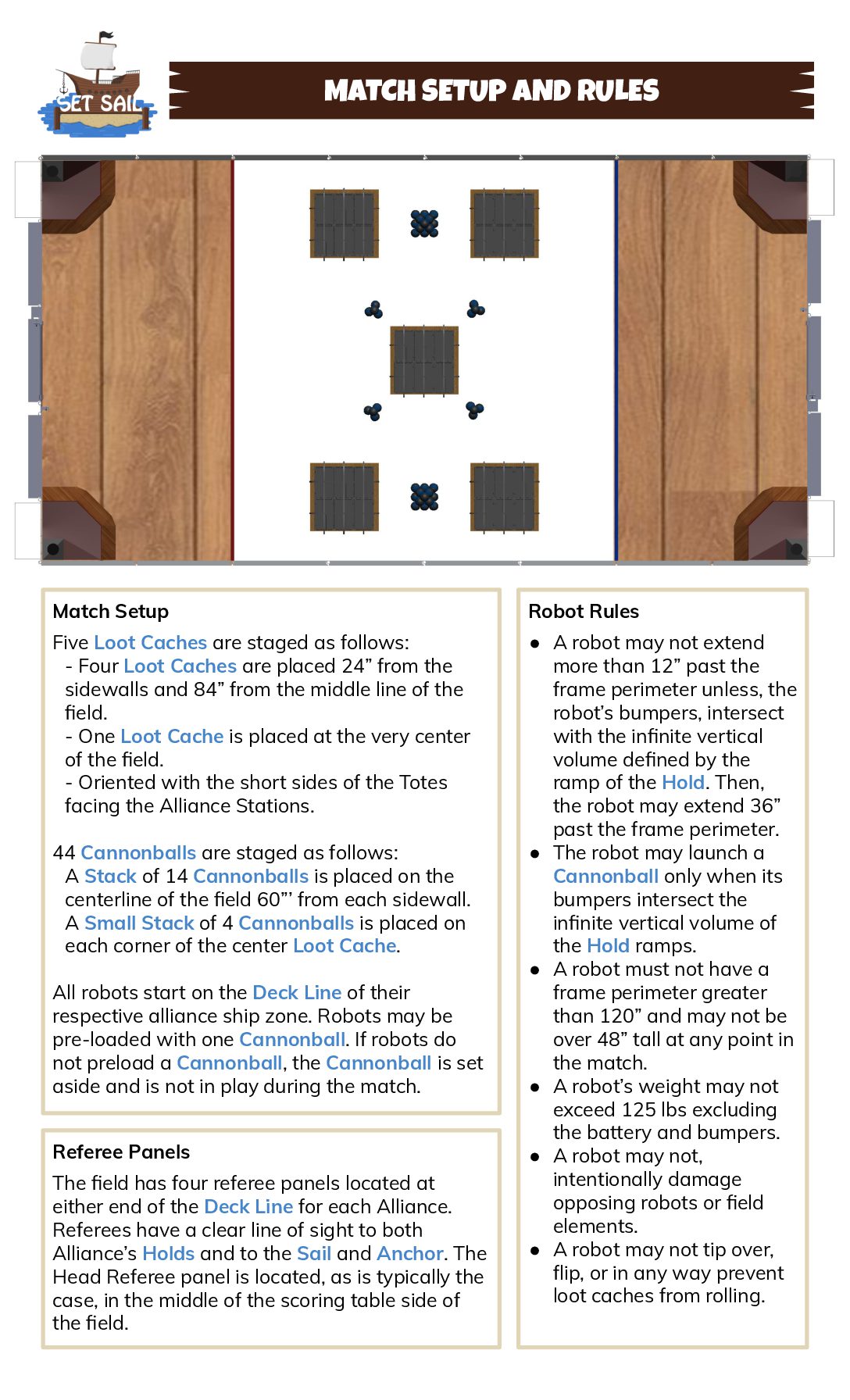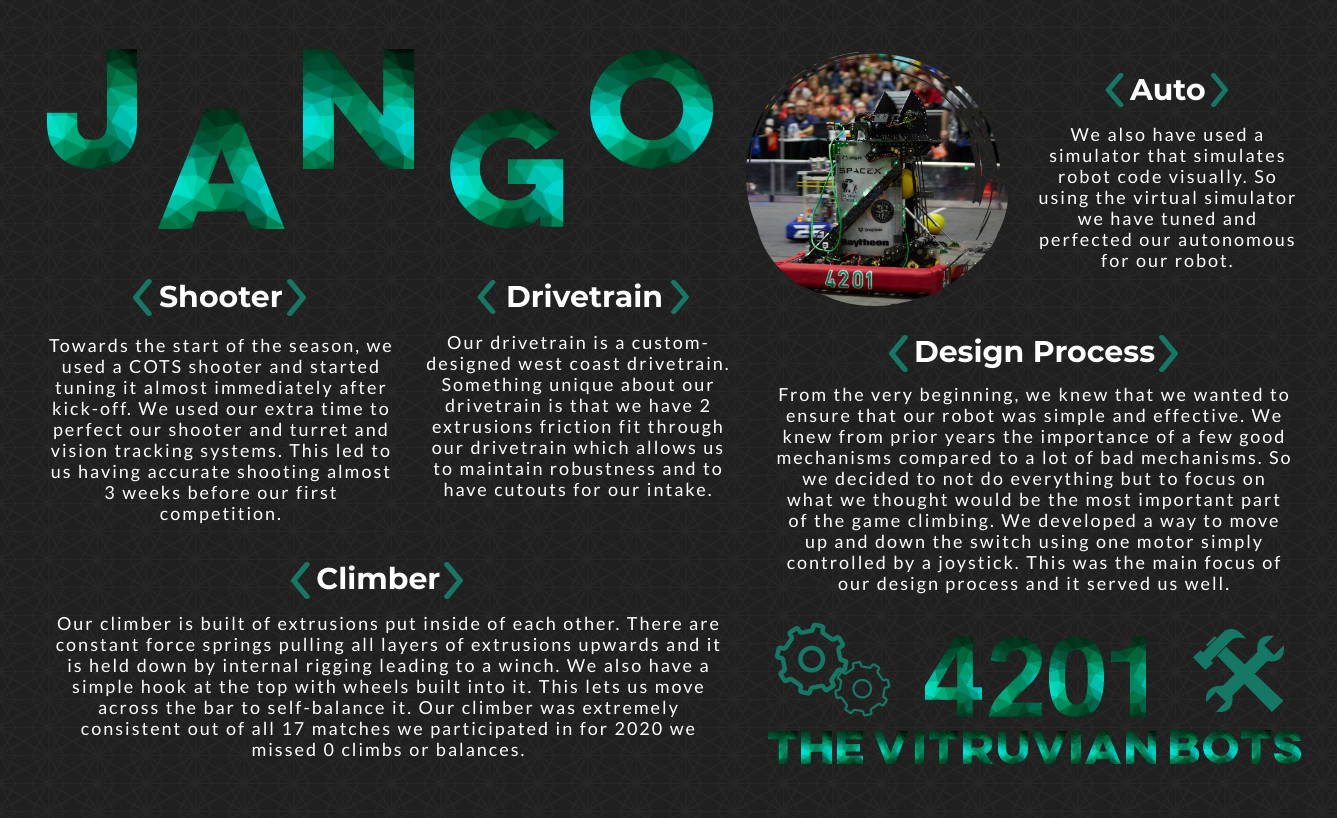2021 Game Changers
Game Design
Infinite Recharge @ Home
Innovation Challenge
Game Design Challenge
First Set Sail Animation Video
Game Overview
In Set Sail, two Alliances of three teams each work to load up their vessel for a long journey across the open seas! Each Alliance, with their trusty crew of humans and robots, race to collect CANNONBALLS and LOOT CACHES to return to the DECK of their ship.
Set SAIL consists of a mostly open field with the two game pieces, CANNONBALLS and LOOT CACHES, located in the center of the field. The CANNONBALLS are four-pound medicine balls, and the LOOT CACHES consist of twelve totes stacked two high and held in place by chains connected to a wheeled platform.
Robots may control up to one CANNONBALL at a time and may score them in the INNER, OUTER, or LOWER goals of their Alliance’s HOLD. The CANNONBALLS are then directed into a CORRAL through ramps built into the HOLD. CANNONBALLS remain in the CORRAL until human players secure them in the ship’s BRASS MONKEY located behind the center Alliance Station. When 9 CANNONBALLS are detected in the BRASS MONKEY, the PEDESTAL lights up to signal that teams can initiate the CANNONBALL BONUS. During the 20-second CANNONBALL BONUS, CANNONBALLS scored in the LOWER and OUTER Goals of the HOLD are worth as much as if they were scored in the INNER goal. As time runs out, Alliances race back to the DECK of their ship with as many LOOT CACHES as possible, hoist their SAIL, and raise their ANCHOR to leave the dock and Set Sail!
During the 15 second Autonomous Period, robots follow pre-programmed instructions. Alliances score points by:
- Moving from the DECK Line
- Scoring CANNONBALLS in their HOLD
- Bringing LOOT CACHES unto their DECK
During the Autonomous period, robots cannot cross the midline of the field, and during the remaining 2 minutes and 15 seconds of the match, drivers take control of the robots. Alliances score points by:
- Continuing to score CANNONBALLS
- Activating the CANNONBALL BONUS
During the final 30 seconds of the match, Alliances can gain extra points by:
- Raising their ANCHOR
- Raising their SAIL
- Parking on the DECK
- Having LOOT CACHES on their DECK
The Alliance with the highest score at the end of the Match wins!
Alliances can gain two ranking points by winning a match or one ranking point by tying a match. Alliances may gain the AUTO LOOT ranking point by having at least two LOOT CACHES on their DECK by the end of Autonomous. Alliances may also gain the ALL ABOARD ranking point by collecting 14 CANNONBALLS in their BRASS MONKEY by the end of the match, raising their ANCHOR, and hoisting their SAIL. All three of these conditions need to be met at the end of the match to get the ALL ABOARD ranking point.
Notable Field Elements
The primary scoring element, the HOLD, has LOWER, OUTER, and INNER scoring goals for CANNONBALLS to be placed in. The goals in the HOLD are accessible to a variety of robots, providing opportunities for teams of all calibers to contribute to the overall objectives of the game. The LOWER goal is designed with a small ramp to allow any robot to simply push a CANNONBALL into their goal. For increased points (and difficulty), teams may raise the CANNONBALL into the scoring ramps above the LOWER goal and into the OUTER goal. To score the most points, while in contact with the HOLD’s ramp, robots are allowed to extend 36” outside of their frame perimeter to place the CANNONBALL in the INNER goal. Sensors are located at the exits from the HOLD to the CORRAL to automatically score CANNONBALLS during a match.
Human players transport scored CANNONBALLS from the CORRALS to the BRASS MONKEY located behind the center Alliance station. This game element is modeled after the actual mechanism used to hold cannonballs securely on ships. Human players will attempt to collect enough CANNONBALLS to create a 14 ball STACK. This is one of the conditions a team will need to meet in order to obtain the ALL ABOARD ranking point.
The SAIL starts the match wrapped around a horizontal bar that is attached to the middle Alliance Station. The top of the sail is connected to a rope that travels around a pulley located at the top of a flag pole placed between the second and third Alliance Stations. The end of the rope hangs about 12” above the floor of the field. As a robot pulls the rope down, the SAIL unwinds from the bar above the center Alliance Station and rises to its full height.
Expected Robot Actions
Since teams gain a ranking point by securing two LOOT CACHES on their DECK prior to the end of Autonomous, we expect teams to prioritize this action. Since the LOOT CACHE in the middle of the field can be contested in Autonomous, teams may design a robot to quickly secure this LOOT CACHE, get additional points, and deny their opponents the additional game piece. There may be some exciting tug-of-war action during more competitive matches where every point counts.
Since there is no reintroduction of CANNONBALLS during the match, teams will need to balance scoring quickly in the lower or outer goals against more points by scoring in the inner goal. This may become more important during more competitive or Championship matches, when there is a potential to clear the field of CANNONBALLS.
With a relatively open field, LOOT CACHES may serve as moveable obstacles for teams to position during the Tele-Op period. A team with 3 LOOT CACHES on their DECK may find it difficult to access their HOLD for scoring, but alliances want as many LOOT CACHES on their DECK as possible at the end of the match. In addition, “defending” robots could reposition LOOT CACHES on the opposing alliance ships to increase CANNONBALL cycle time.
At the end of the match, we anticipate defending robots to try to “steal” a LOOT CACHE from the opposing alliance to bring onto their DECK before time runs out. Each LOOT CACHE captured this way can swing the game by 20 points.
Robots are also incentivized to be on the DECK of their ship when time runs out to get parking points and to be in position to manipulate the ANCHOR and SAIL game elements. Robots cannot contact an opposing robot that is completely in their DECK during the End Game.
Use of Chain
Set Sail incorporates the Game Design Element, chain, in two unique ways. The first way is by raising the ANCHOR. The ANCHOR is attached to a chain that travels around a pulley located between the first and second Alliance Stations. The end of the chain hangs about 12” from the field’s floor. As a robot pulls the chain down, the ANCHOR rises. Using the chain in this manner is appropriate to the theme since real ship anchors are often connected to the ship with a chain.
The second way that Set SAIL incorporates chain is with the LOOT CACHES. This unique game piece is meant to simulate a sizable amount of that cargo that is loaded on ships. The 12 standard FIRST totes represent this cargo, and the chain is used to secure the totes to the rolling platform. A lot of thought was put into the size of the platform, position of the wheels, and how to secure the totes to minimize motion while robots manipulate the platform. Eyebolts and carabiners are used to tightly secure the chain over the totes in two directions. Teams may grab the chain to manipulate the LOOT CACHES, potentially creating dual-use mechanisms that can be also used during the End Game for raising the ANCHOR. Teams may also choose to bypass using the chain and push or pull the LOOT CACHES using the platform or even through direct contact with the totes. There are vision targets on the totes that line up with the chain, so we anticipate teams will target the chain during Autonomous to quickly secure the LOOT CACHE for bonus points.
Infinite Recharge @ Home
Skill’s Challenge Compilation
Innovation Challenge
Business Pitch Video
Innovation Challenge Executive Summaries Problem
Team 4201 is focusing on the problem of sedentary behavior (sitting for unhealthy durations of time), which has become more prevalent during the COVID-19 pandemic. The research we conducted included 3 interviews with experts on mental and physical health problems and 21 articles, 10 YouTube videos, and 3 websites. Through this research, we found that one sports medicine doctor stated, “sitting for long periods is linked with some types of cancers and heart disease and can contribute to diabetes, kidney, and liver problems. … inactivity causes about 9% of premature deaths a year. That’s over 5 million people.” This demonstrates the alarming negative effects of prolonged sitting has on the human body. Our team also found additional negative impacts that sitting for extended periods of time can have on the human body such as decreased productivity levels in the brain, lower energy levels, and disruption of blood flow. Not only does prolonged sitting affect the human body, but our economy has suffered huge losses from it as well. As estimated by the National Library of Medicine, physical inactivity has caused an economic burden of over $53 billion on worldwide healthcare systems in 2013. After identifying this commonly overlooked and significant concern in modern societies, which has only worsened due to the COVID-19 pandemic, our team decided to find a solution to combat prolonged sitting.




